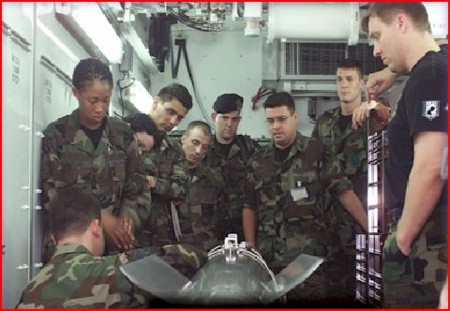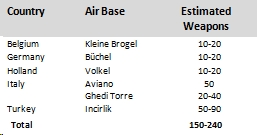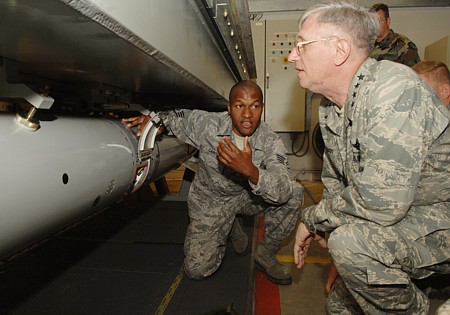USAF Report: “Most” Nuclear Weapon Sites In Europe Do Not Meet US Security Requirements
 |
| Members of the 704 Munition Support Squadron at Ghedi Torre in Italy are trained to service a B-61 nuclear bomb inside a Munitions Maintenance Truck. Security at “most” nuclear bases in Europe does not meet DOD safety requirements, a newly declassified U.S. Air Force review has found. Withdrawal from some is rumored. Image: USAF |
.
By Hans M. Kristensen [article updated June 26 following this report]
An internal U.S. Air Force investigation has determined that “most sites” currently used for deploying nuclear weapons in Europe do not meet Department of Defense security requirements.
A summary of the investigation report was released by the Pentagon in February 2008 but omitted the details. Now a partially declassified version of the full report, recently obtained by the Federation of American Scientists, reveals a much bigger nuclear security problem in Europe than previously known.
As a result of these security problems, according to other sources, the U.S. plans to withdraw its nuclear custodial unit from at least one base and consolidate the remaining nuclear mission in Europe at fewer bases.
European Nuclear Safety Deficiencies Detailed
The national nuclear bases in Europe, those where nuclear weapons are stored for use by the host nation’s own aircraft, are at the center of the findings of the Blue Ribbon Review (BRR), the investigation that was triggered by the notorious incident in August 2007 when the U.S. Air Force lost track of six nuclear warheads for 36 hours as they were flow across the United States without the knowledge of the military personnel in charge of safeguarding and operating the nuclear weapons.
|
Figure 1: |
 |
|
“Most” nuclear sites in Europe don’t meet DOD security standards, according to the Blue Ribbon Review report. |
The final report of the investigation – Air Force Blue Ribbon Review of Nuclear Weapons Policies and Procedures – found that “host nation security at overseas nuclear-capable units varies from country to country in terms of personnel, facilities, and equipment.” The report describes that “inconsistencies in personnel, facilities, and equipment provided to the security mission by the host nation were evident as the team traveled from site to site….Examples of areas noted in need of repair at several of the sites include support buildings, fencing, lighting, and security systems.”
The situation is significant: “A consistently noted theme throughout the visits,” the BRR concluded, “was that most sites require significant additional resources to meet DOD security requirements.” Despite overall safety standards and close cooperation and teamwork between U.S. Air Force personnel and their host nation counterparts, the inspectors found that “each site presents unique security challenges.”
Specific examples of security issues discovered include conscripts with as little as nine months active duty experience being used protect nuclear weapons against theft.
Inspections can hypothetically detect deficiencies and inconsistencies, but the BRR team found that U.S. Air Force inspectors are hampered in performing “no notice inspections” because the host nations and NATO require advance notice before they can visit the bases. If crews know when the inspection will occur, their performance might not reflect the normal situation at the base.
Many of the safety issues discovered are precipitated by the fact that the primary mission of the squadrons and wings is not nuclear deterrence but real-world conventional operations in support of the war on terrorism and other campaigns. This dual-mission has created a situation where many nuclear positions are “one deep,” and where rotations, deployments, and illnesses can cause shortfalls.
The review recommended consolidating the bases to “minimize variances and reduce vulnerabilities at overseas locations.”
USAFE Commander Visits Nuclear Bases
In light of the findings about Air Force nuclear security, General Roger Brady, the USAFE Commander, on June 11 visited Kleine Brogel Air Base in Belgium and Volkel Air Base in Holland. Both bases store U.S. nuclear weapons for delivery by their national F-16 fighters.
.
A news story on a USAF web site notes that the weapons security issues found by the BRR investigation were “at other bases,” suggesting that Büchel Air Base in Germany or Ghedi Torre Air Base in Italy were the problem. Even so, the BRR found problems at “most sites,” visits to Kleine Brogel and Volkel were described in the context of these findings. Two commanders of the 52 Fighter Wing at Spangdahlem Air Base, which controls the 701st and 703rd Munitions Support Squadrons at the national bases, were also present “to witness both units for the first time.”
Withdrawal and Consolidation
The deficiencies at host nation bases apparently have triggered a U.S. decision to withdraw the Munition Support Squadron (MUNSS) from one of the national bases.
Four MUNSS are currently deployed a four national bases in Europe: the 701st MUNSS at Kleine Brogel Air Base in Belgium, the 702nd MUNSS at Büchel Air Base in Germany, the 703rd MUNSS at Volkel Air Base in Holland, and the 704th MUNSS at Ghedi Torre in Italy (see top image).
It is not yet known which base it is, but sources indicate that it might involve the 704th MUNSS at Ghedi Torre in Northern Italy.
Status of Nuclear Weapons Deployment [June 26: warhead estimate updated here]
The number and location of nuclear weapons in Europe are secret. However, based in previous reports, official statements, declassified documents and leaks, a best estimate can be made that the current deployment consists of approximately 150-240 B61 nuclear bombs (see update here). The most recent public official statement was made by NATO Vice Secretary General Guy Roberts in an interview with the Italian RAINEWS in April 2007: “We do say that we’re down to a few hundred nuclear weapons.”
|
Table 1: |
 |
|
Derived from more extensive table. Click table or here to download the full table. |
The U.S. weapons are stored in underground vaults, known as WS3 (Weapon Storage and Security System), at bases in Belgium, Germany, Holland, Italy, and Turkey. Most of the weapons are at U.S. Air Force bases, but Belgium, Germany, Holland and Italy each have nuclear weapons at one of their national air bases.
The weapons at each of the national bases are under control of a U.S. Air Force MUNSS in peacetime but would, upon receipt of proper authority from the U.S. National Command Authority, be handed over to the national Air Force at the base in a war for delivery by the host nation’s own aircraft. This highly controversial arrangement contradicts both the Non-Proliferation Treaty and NATO’s international nonproliferation policy.
Implications and Observations
The main implication of the BRR report is that the nuclear weapons deployment in Europe is, and has been for the past decade, a security risk. But why it took an investigation triggered by the embarrassing Minot incident to discover the security problems in Europe is a puzzle.
Since the terrorist attacks in September 2001, billions of dollars have been poured into the Homeland Security chest to increase security at U.S. nuclear weapons sites, and a sudden urge to improve safety and use control of nuclear weapons has become a principle justification in the administration’s proposal to build a whole new generation of Reliable Replacement Warheads.
But, apparently, the nuclear deployment in Europe has been allowed to follow a less stringent requirement.
This contradicts NATO’s frequent public assurances about the safe conditions of the widespread deployment in Europe. Coinciding with the dramatic reduction of nuclear weapons in Europe after the Cold War 15 years ago, “a new, more survivable and secure weapon storage system has been installed,” a NATO fact sheet from January 2008 states. “Today, the remaining gravity bombs associated with DCA [Dual-Capable Aircraft] are stored safely in very few storage sites under highly secure conditions.”
Apparently they are not. Yet despite the BRR findings, the NATO Nuclear Planning Group meeting in Brussels last week did not issue a statement. But at the previous meeting in June 2007 the group reaffirmed the “great value” of continuing the deployment in Europe, “which provide an essential political and military link between the European and North American members of the Alliance.”
That NATO – nearly two decades after the Cold War ended – believes it needs U.S. tactical nuclear weapons in Europe to keep the alliance together is a troubling sign. NATO air forces are stretched thin to meet real-world operations in the war against terrorism and other campaigns, and tactical nuclear weapons are not a priority, no matter what nuclear bureaucrats might claim.
Even Republican presidential candidate John McCain apparently does not believe tactical nuclear weapons in Europe are essential for NATO. On May 27 he stated that, if elected, he would, “in close consultation with our allies…like to explore ways we and Russia can reduce – and hopefully eliminate – deployments of tactical nuclear weapons in Europe.”
Many European governments would support such a plan – even though some of the new eastern European NATO members see Russian resurgence as a reason to continue the deployment. But their security concerns can be met by other means, and Germany and Norway have already been pushing a proposal inside NATO for a review of the alliance’s nuclear policy, the Belgium parliament has called for a withdrawal, and there is overwhelming cross-political public support in Germany to end the deployment in Europe.
Perhaps the BRR findings will help empower these countries and convince NATO and the next U.S. administration that the time has come to finally complete the withdrawal of tactical nuclear weapons from Europe.
Additional Information: Blue Ribbon Review (2008 report) | United States Removes Nuclear Weapons From German Base, Documents Indicate (2007 report) | US Nuclear Weapons in Europe (2005 report)
The FY2026 National Defense Authorization Act (NDAA) paints a picture of a Congress that is working to both protect and accelerate nuclear modernization programs while simultaneously lacking trust in the Pentagon and the Department of Energy to execute them.
While advanced Chinese language proficiency and cultural familiarity remain irreplaceable skills, they are neither necessary nor sufficient for successful open-source analysis on China’s nuclear forces.
Satellite imagery has long served as a tool for observing on-the-ground activity worldwide, and offers especially valuable insights into the operation, development, and physical features related to nuclear technology.
This report outlines a framework relying on “Cooperative Technical Means” for effective arms control verification based on remote sensing, avoiding on-site inspections but maintaining a level of transparency that allows for immediate detection of changes in nuclear posture or a significant build-up above agreed limits.
